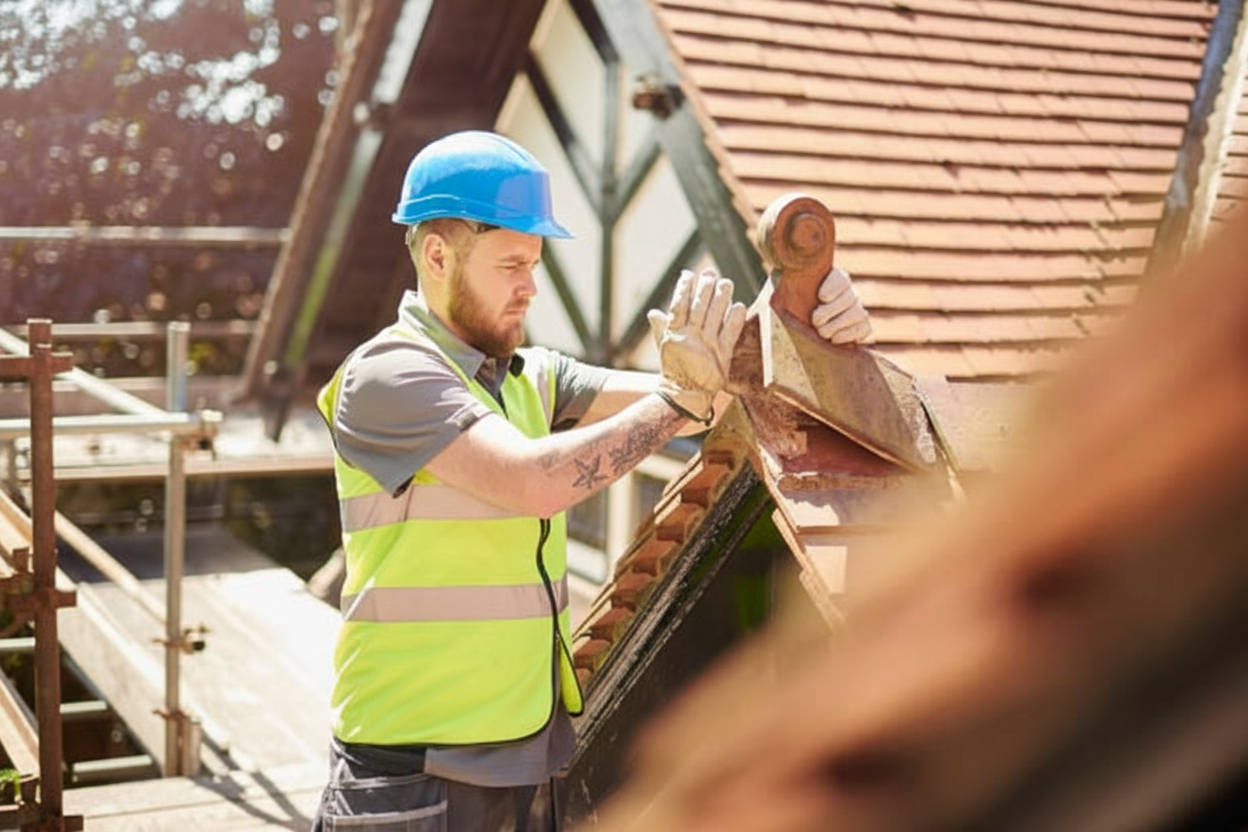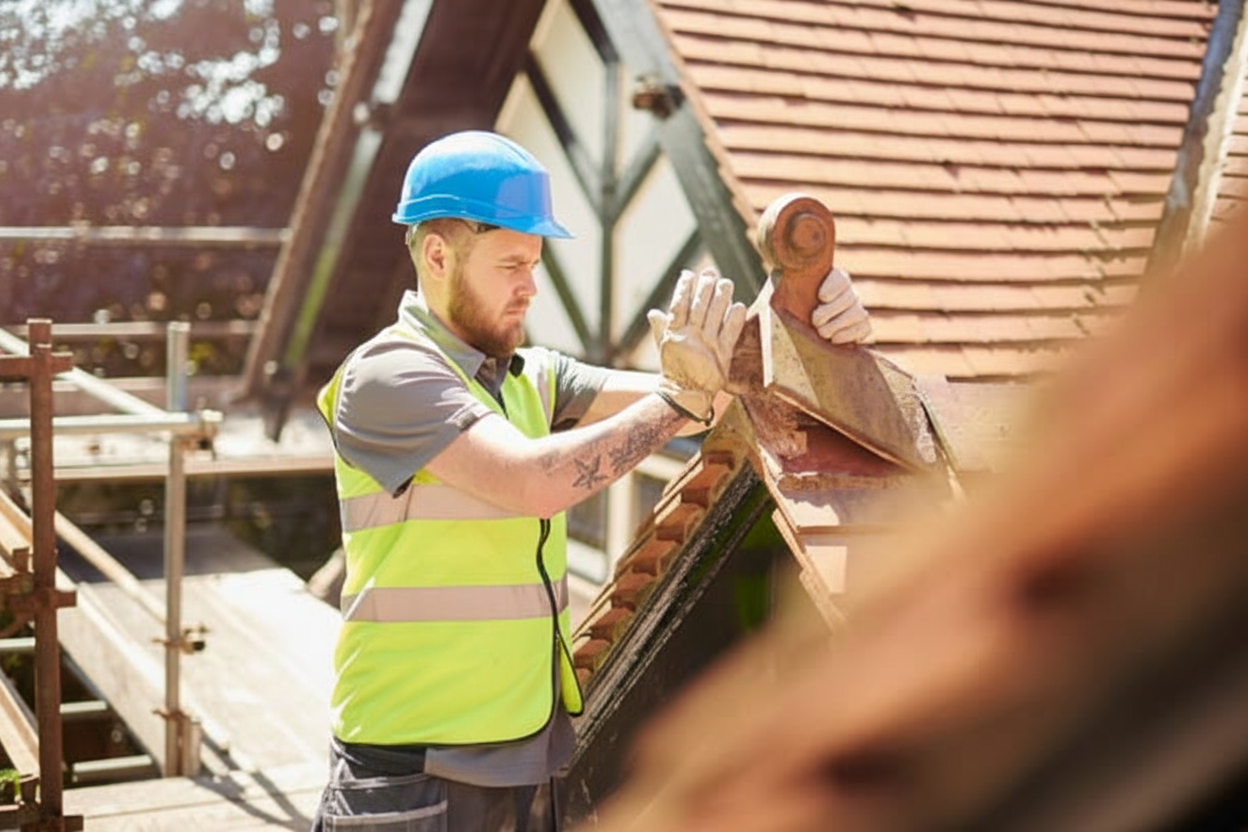
When to Replace Your Tile Roof: Signs, Benefits & Cost Guide 2025
Maintenance & Repair
Tile Roofing Installation
October 6,2025
When to Replace Your Tile Roof: Signs, Benefits & Cost Guide 2025

Alt text: Professional roofing contractors installing new tile roof with safety equipment
Tile roofs are among the most durable roofing systems available, but even the best materials need replacement eventually. Knowing when to replace your tile roof can save you thousands in water damage repairs and energy costs. Whether you have clay, concrete, or terracotta tiles, understanding the signs of wear and the benefits of timely replacement helps you make informed decisions about your home’s protection.
Tile roofs can last 50+ years with proper maintenance, but most homeowners wait too long to address underlying issues. Catching problems early prevents costly structural damage.
Recognizing when your tile roof needs replacement
Your roof constantly communicates its condition through visible and hidden signs. Understanding these indicators helps you act before minor issues become major expenses.
Visible damage and wear patterns
Cracked, broken, or missing tiles are the most obvious red flags. While individual tile repairs can address isolated damage, widespread cracking across multiple roof sections signals that replacement is necessary. Walk around your property and inspect for tiles on the ground after storms, which indicates serious attachment problems.
Fading or discoloration across large roof areas suggests your tiles have reached the end of their protective lifespan. The protective coating that shields tiles from UV damage deteriorates over time, leaving the material vulnerable to accelerated wear.
Hidden structural concerns
The underlayment beneath your tiles typically fails before the tiles themselves. Most underlayment materials last 20-30 years, and once compromised, they allow moisture to penetrate your roof deck. Signs include water stains on ceilings, mold growth in attics, or a musty smell in upper floors.
Sagging sections indicate structural damage to roof decking or support beams. This requires immediate professional inspection, as it poses safety risks beyond simple water intrusion. If you notice your tile roof showing signs of wear, schedule an evaluation promptly.
Underlayment failure is the leading cause of tile roof replacement needs. Even intact tiles cannot protect your home once the waterproof barrier fails.
Age and performance factors
| Tile Type | Expected Lifespan | Replacement Indicators |
|---|---|---|
| Clay | 50-100 years | Widespread cracking, underlayment failure |
| Concrete | 40-50 years | Surface erosion, color fading |
| Terracotta | 50-100+ years | Moisture penetration, structural issues |
Even if your tiles appear intact, consider factors that affect tile roof longevity like your local climate, installation quality, and maintenance history. A 40-year-old concrete tile roof in harsh weather conditions likely needs replacement regardless of surface appearance.
Benefits of timely tile roof replacement
Replacing your tile roof at the right time protects your investment and enhances your home’s value. Waiting too long transforms a straightforward roof replacement into an expensive structural repair project.
Energy efficiency improvements
Modern tile roofing systems include advanced underlayment and ventilation features that significantly reduce energy costs. New tiles with reflective coatings can lower attic temperatures by 20-30 degrees, reducing air conditioning loads during summer months.
Comparing tile versus shingle roofs in Florida shows that properly installed tile systems provide superior insulation value, potentially saving hundreds annually on utility bills.
Enhanced protection and peace of mind
A new tile roof includes updated flashing, proper ventilation, and modern waterproofing materials that work together as a complete system. This integrated approach prevents the common failure points that plague aging roofs.
You gain warranty coverage on both materials and labor, typically ranging from 15-50 years depending on tile type and installer. This protection offers financial security against unexpected roofing expenses.

Alt text: Homeowner and contractor reviewing tile roof replacement options during property inspection
Investing in quality installation matters as much as tile selection. Poor tile roof installation practices can reduce a 50-year roof to a 20-year problem.
Property value increase
Real estate professionals consistently report that homes with new tile roofs command premium prices. Buyers appreciate the long-term value and reduced maintenance requirements that tile roofing provides.
The aesthetic appeal of fresh tiles, whether you choose Spanish tile, terracotta, or concrete options, dramatically improves curb appeal and neighborhood standing.
Planning your tile roof replacement project
Successful roof replacement requires careful planning and informed decision-making. Following a systematic approach ensures you get the best value and performance from your investment.
Selecting the right tile material
Your choice between clay, concrete, and composite tiles affects both upfront costs and long-term performance. Clay versus concrete tile comparison reveals that clay offers superior longevity but higher initial costs, while concrete provides excellent value with good durability.
Consider your home’s architectural style and structural capacity. Some older homes require reinforcement to support heavier clay or concrete tiles. Exploring different tile roof types helps you understand which materials complement your home’s design.
Working with qualified contractors
Choose contractors with specific tile roofing experience and proper licensing. Request references from recent tile roof projects and verify their insurance coverage includes both liability and workers compensation.
Quality installers understand proper tile roof underlayment selection and installation techniques that prevent future problems. They also know how to walk on tile roofs without causing damage during installation.
Understanding costs and timeline
Tile roof replacement typically costs between $15,000 and $50,000 depending on roof size, tile type, and structural repairs needed. Clay tile roof costs vary significantly by region and material grade.
Most projects take 5-10 days for completion, though larger or more complex roofs may require additional time. Weather conditions and material availability can affect scheduling, so plan your project during favorable seasons when possible.
Maintaining your investment after replacement
Proper maintenance extends your new tile roof’s lifespan and protects your investment. Establishing good habits from the start prevents premature wear and identifies small issues before they become expensive problems.
Regular inspection schedule
Inspect your roof twice yearly, in spring and fall, looking for cracked tiles, displaced pieces, or debris accumulation. After severe weather events, perform additional visual checks from ground level.
Professional inspections every 3-5 years catch problems invisible from the ground. Experts identify underlayment issues, flashing failures, and structural concerns that homeowners typically miss.
Cleaning and upkeep
Clean your tile roof every 1-2 years to prevent organic growth and maintain appearance. Tile roof cleaning methods vary by tile type, but most benefit from low-pressure washing and appropriate cleaning solutions.
For terracotta tile cleaning, use gentle techniques that preserve the tile’s natural finish. Avoid high-pressure washing that can damage tiles or force water under the roofing system.
Addressing issues promptly
Fix damaged tiles immediately to prevent water intrusion. Tile roof leak repair becomes more complex when delayed, as moisture causes progressive damage to underlayment and decking.
Keep spare tiles from your installation for future repairs, ensuring perfect color and texture matching. Most tile manufacturers change styles and colors over time, making exact matches difficult years later.
